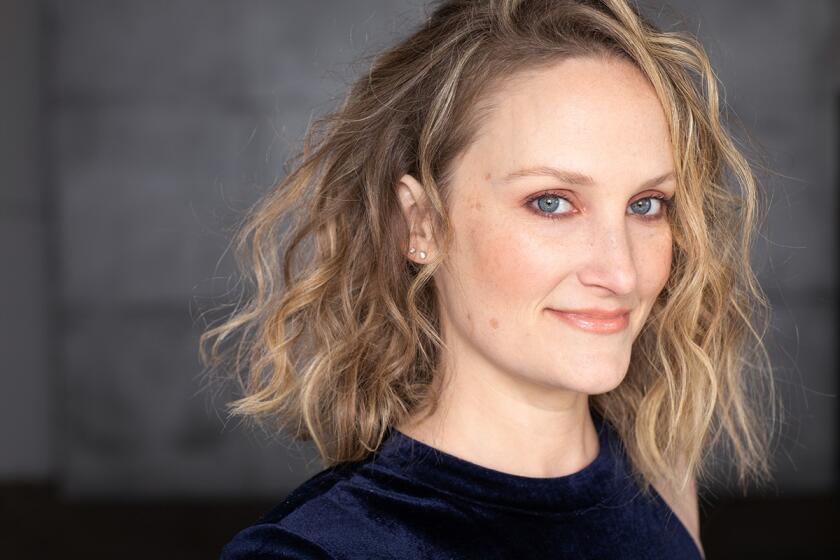Flannery O’Connor and the art of prayer
Flannery O’Connor was not a casual Catholic. “What people don’t realize is how much religion costs,” she writes in “The Habit of Being,” a collection of her letters. “They think faith is a big electric blanket, when of course it is the cross. It is much harder to believe than not to believe.”
From her earliest days, O’Connor struggled to reconcile this belief with her ambition, and her understanding that evil exists in the world.
“Sin is a great thing as long as it’s recognized,” she argues in “A Prayer Journal” (Farrar, Straus and Giroux: 96 pp., $18). “It leads a good many people to God who wouldn’t get there otherwise. But cease to recognize it or take it away from devil as devil & give it to devil as psychologist and you also take away God. If there is no sin in this world there is no God in heaven. No heaven.”
“A Prayer Journal” is the first volume of previously unavailable O’Connor writings to be published in three decades, since the University of Georgia put out a collection of her book reviews in 1983.
She composed the entries here between January 1946 and September 1947, beginning when she was 20 and abandoning the project when she was 22. At the time, she was a student at the Iowa Writers Workshop, and her desire not just to write but to be an author of consequence underscores nearly every page.
“I must write down that I am to be an artist,” she notes in April 1947. “Not in the sense of aesthetic frippery but in the sense of aesthetic craftsmanship; otherwise I will feel my loneliness constantly — like this today.”
At the heart of such a statement is not just what it means to be a writer but, more specifically, what it meant to O’Connor to be a writer; “A Prayer Journal” is nothing if not a set of specific pleas. “Dear God, I cannot love Thee the way I want to,” she begins the diary, and to some extent, it is this longing for God, for connection to the ineffable, that motivates her ambition and desire.
Again and again here, O’Connor asks for humility, to be removed from herself: “My dear God,” she writes in the early pages, “I do not want this to be a metaphysical exercise but something in praise of God.” And yet, through it all, we have the sense of “A Prayer Journal” as intensely written, with an arc, a point of view, even characters.
Take God, for instance, to whom these entries are addressed. Although O’Connor is careful to write in supplication, her wish for communication, for engagement, is at the center of the dialogue.
Her God, in other words, is not the God of Nancy Mairs, who in her 2007 book “A Dynamic God,” suggests that faith — and, for that matter, “God Godself” — exists almost entirely beyond our comprehension.
“The need to reduce God,” Mairs argues, “to a person having mental states with which we are familiar — desire, anger, retribution (but seldom, alas, a sense of humor) — does God little service and ourselves even less.”
O’Connor, I think, would not disagree with that, but in these early pages, she is, as she always was, a writer first. In her imagining, God becomes a sly sort of a pen pal, ever-present but inscrutable, demanding but affectionate.
Partly, this has to do with O’Connor’s own sense of humor, her appreciation of the grotesque. This is a key element in her fiction, and it emerges here in unexpected ways.
“I believe in hell,” she writes. “Hell seems a great deal more feasible to my weak mind than heaven. No doubt because hell is a more earthly seeming thing. I can fancy the tortures of the damned but I cannot imagine the disembodied souls hanging in a crystal for all eternity praising God. It is natural that I should not imagine this. If we could accurately map heaven some of our up-&-coming scientists would begin drawing blueprints for its improvement, and the bourgeois would sell guides 10 [cents] the copy to all over 65.”
That’s a wicked image — cynical about humanity and all its failings and yet still infused with a sinner’s love. And O’Connor follows it with the most stunning revelation in “A Prayer Journal”: “But I do not mean to be clever although I do mean to be clever on 2nd thought and like to be clever & want to be considered so.” There it is in a nutshell, the inner conflict at the center of the journal, humility and ego all bound up together in the writer’s voice.
It is this — the image of a writer aware of herself and what she is doing — that makes “A Prayer Journal” more than just a lose collection of notes but rather a coherent work on its own terms. It is, as O’Connor suggests, a prayer in narrative form, an ongoing set of meditations, a reflection on her relationship with God.
But even more, it is a record of her own internal inquiries, which would later fuel her novels and short stories: “Wise Blood,” “Parker’s Back,” “A Good Man is Hard to Find.”
For O’Connor, sin and faith and redemption are all bound up together as we makes our way through this dark forest of a world.
Or, as she writes here, in the closing entry: “My thoughts are so far away from God. He might as well not have made me. And the feeling I egg up writing here lasts approximately a half hour and seems a sham. I don’t want any of this artificial superficial feeling stimulated by the choir.”
ALSO:
Hilton Als blurs the lines in ‘White Girls’
Harryette Mullen walks Los Angeles into verse
‘Darling’ takes on spirituality in Richard Rodriguez’s terms
More to Read
Sign up for our Book Club newsletter
Get the latest news, events and more from the Los Angeles Times Book Club, and help us get L.A. reading and talking.
You may occasionally receive promotional content from the Los Angeles Times.









